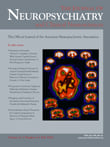To the Editor: Duloxetine, an antidepressant, is approved for treating major depressive disorder, general anxiety disorder, and diabetic peripheral neuropathic pain. There is much evidence that antidepressants, including duloxetine, could have an antinociceptive effect,
1 even in psychogenic or somatoform pain.
2 Primary Raynaud’s phenomenon is caused by reversible digital vasospasms without organic basis and results from or is exacerbated by stress. To our knowledge, there is no case report on the successful treatment of Raynaud’s phenomenon with duloxetine.
Case Report
Mrs. A, a 46-year-old woman, had Raynaud’s phenomenon in her hands for 5 years. She had no major systemic illness or substance use and was not in a perimenopausal stage. Five years ago, she suffered from headache, neck/shoulder pain, and gradual pain in four limbs. In addition, she developed intermittent bilateral hand numbness, pain, and cyanosis (more than 10 times/day), while clear digital color changes (white, red, then purple) could be observed without nail fold capillaroscopic abnormality. For severely impaired life quality, therapeutic physical therapies such as exercise, hydrotherapy, and heat-therapy were applied repeatedly, but without success. Three years later she was admitted for rheumatologic survey, but tests including spinal films, wrist sonography, electromyography, nerve conduction velocity tests, thyroid, renal and liver function, electrolytes (mg: 2.3 and Ca: 9.2 mg/dl), and cortisol (21.99 μg/dl) presented negative findings. Autoantibodies were all negative (antidsDNA: 15 IU/ml, antinuclear autoantibodies:(-), SSA(Ro): 0.2, SSB(La): 1.4 U/ml), and she had normal erythrocyte sedimentation rate and rheumatoid factor. In face of this resistance to conservative treatment, she visited a psychiatric clinic. No pathological depression or anxiety was present (Montgomery Åsberg Depression Rating Scale score =2, Hamilton Anxiety Rating Scale score =6), but objective stress from her job was noted. Under the impression of pain disorder according to DSM-IV criteria, duloxetine, 60 mg/day, was prescribed. The symptom checklists-90 showed all subscales below mild grade (somatization =0.25, paranoid ideation =0.17). Initially, she was intolerable to duloxetine, 60 mg/day, with sweating and somnolence, and her dosage was reduced to 30 mg/day. The pain showed rapid improvement 2 weeks later, from 9 points to 5 points on the 10-point visual analogue scale. Although pain fluctuated whenever her work load increased, she felt satisfied with the resolution. Four months later, her pain showed 80% improvement. Another 1–2 months later, she reported unexpected relief with decreased frequency of Raynaud’s phenomenon and increased cold tolerance without other therapy. The patient continues to work as a full-time nurse with better stress tolerability and life quality and fewer medical visits.
Discussion
Our report demonstrated the efficacy of duloxetine in treating unexplained painful symptoms and Raynaud’s phenomenon without definite organic basis, which may be explained by its dual actions through increased serotonin and norepinephrine centrally. Although not well-known in the pathogenesis of Raynaud’s phenomenon, factors promoting vasoconstriction and decreasing vasodilatation play a role, including increased serum serotonin and alpha2-adrenoreceptor overactivity.
3 Attacks of Raynaud’s phenomenon are triggered by stress,
3 which is also related to central serotonergic and noradrenergic dysregulation.
4,
5 Our patient’s Raynaud’s phenomenon improved, and her stress tolerability increased later, possibly through modification of hypothalamic-pituitary-adrenal and immune axes.
4 Our case highlights a dual-action antidepressant, duloxetine, is possibly effective in both unexplained pain and Raynaud’s phenomenon.

